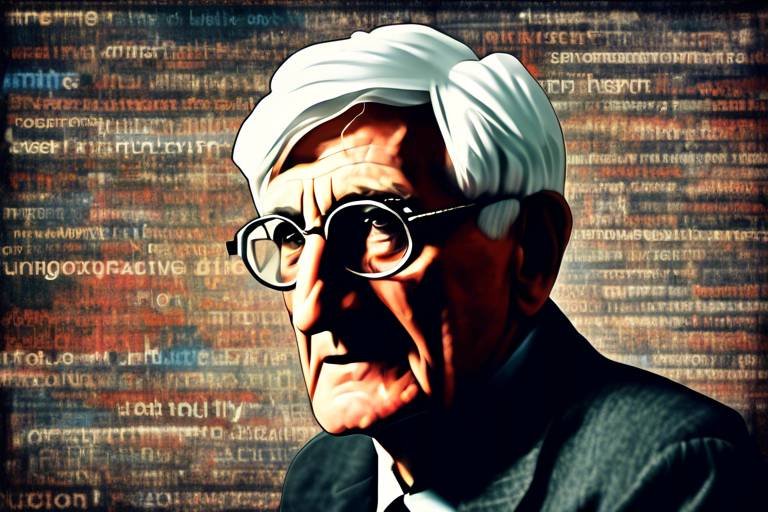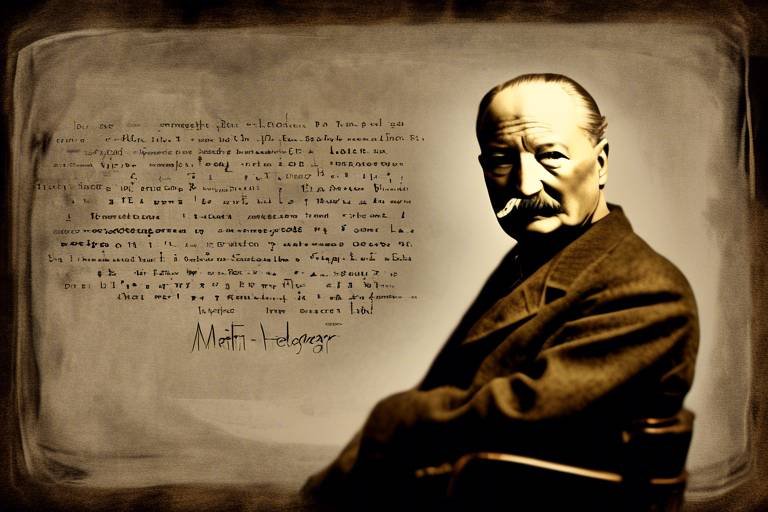Jurgen Habermas and the Theory of Communicative Action
In the realm of social theory, few thinkers have made as significant an impact as Jurgen Habermas. His Theory of Communicative Action offers a profound insight into the way we interact, emphasizing the importance of communication in shaping our social reality. Habermas argues that through effective dialogue, individuals can achieve mutual understanding and build consensus, which is crucial not only for personal relationships but also for the functioning of democracy itself. This article will take you on a journey through Habermas's ideas, exploring the intricate web of communication that binds us together in society.
Habermas's work is particularly relevant in today's world, where communication often seems fragmented and polarized. In an era dominated by social media and instant messaging, understanding his theory can provide valuable tools for navigating the complexities of modern discourse. So, what exactly is the Theory of Communicative Action, and how can it help us foster better communication in our daily lives? Let's dive deeper into this fascinating topic.
Jurgen Habermas, a prominent figure in contemporary philosophy, was born in Germany in 1929 and has since become a leading voice in social theory. His philosophical journey is deeply rooted in the Frankfurt School of critical theory, where he sought to address the challenges posed by modernity and the changing landscape of human interaction. One of his key contributions is the concept of communicative rationality, which challenges traditional notions of rationality that often prioritize individualistic and strategic thinking.
Habermas posits that understanding human interactions requires a shift towards a more communicative approach, where dialogue and reasoned argumentation take center stage. This perspective not only enriches our understanding of social dynamics but also lays the groundwork for a more inclusive and participatory democratic process. By emphasizing the role of communication in shaping our social reality, Habermas invites us to reconsider how we engage with one another in both personal and political contexts.
At the heart of Habermas's theory lies the concept of communicative action. Unlike strategic action, which is driven by individual goals and often results in manipulation or coercion, communicative action is rooted in the desire for mutual understanding. It's about coming together to share ideas, negotiate differences, and find common ground. Imagine a group of friends discussing where to eat: instead of one person pushing their favorite restaurant, they engage in a dialogue, weighing everyone's preferences until they reach a consensus. This is the essence of communicative action.
Habermas's notion of rationality is pivotal in understanding communicative action. He argues that true rationality emerges from dialogue, where participants engage in reasoned argumentation. This process is not just about exchanging information; it's about fostering a genuine understanding of one another's perspectives. By prioritizing dialogue, individuals can transcend their biases and work towards a shared understanding, which is essential for social cohesion.
Language serves as the primary medium for communicative action. It is through language that we express our thoughts, share our experiences, and negotiate our differences. Habermas emphasizes that language is not merely a tool for communication; it is a vehicle for social integration. When we share meanings and understandings through language, we create bonds that unite us as a community. This shared linguistic framework is crucial for fostering a sense of belonging and collaboration in society.
For communication to be effective, certain conditions must be met. Habermas identifies three key elements that are vital for achieving mutual understanding:
- Sincerity: Participants must be genuine in their intentions and open to understanding differing viewpoints.
- Comprehensibility: The message must be clear and understandable to all parties involved.
- Absence of Coercion: Communication should occur in a context free from pressure or manipulation, allowing for authentic dialogue.
When these conditions are met, the potential for meaningful communication and consensus-building increases significantly, paving the way for stronger social ties and democratic practices.
Despite its strengths, Habermas's theory has faced various critiques. Some argue that the ideal conditions for communicative action are rarely, if ever, achieved in real-world situations. Factors such as power imbalances, cultural differences, and social inequalities can hinder effective communication. Critics also question whether genuine consensus is possible in a pluralistic society where diverse perspectives often clash. However, these critiques do not diminish the value of Habermas's insights; instead, they highlight the challenges we must navigate in our quest for better communication.
Habermas's Theory of Communicative Action has profound implications for democratic practices. Effective communication is the backbone of a thriving democracy, enabling public deliberation and participation in political processes. When citizens engage in open dialogue, they can better articulate their needs and concerns, fostering a more inclusive political landscape.
One of Habermas's most significant contributions is the concept of the public sphere, a space where individuals come together to discuss societal issues and engage in deliberative democracy. In this context, discourse plays a crucial role in shaping public opinion and influencing policy decisions. The public sphere serves as a platform for diverse voices, allowing for a richer exchange of ideas and perspectives.
In today's digital age, the challenges to communicative action are more pronounced than ever. The rise of social media has transformed the way we communicate, often leading to fragmented and polarized discourse. The challenge lies in finding ways to foster understanding amidst this fragmentation. Habermas's insights remind us of the importance of engaging in meaningful dialogue, even in the face of differing opinions. By striving for genuine communication, we can work towards a more cohesive and understanding society.
- What is the main idea behind Habermas's Theory of Communicative Action?
Habermas's theory emphasizes the importance of communication in achieving mutual understanding and consensus in social interactions. - How does communicative action differ from strategic action?
Communicative action is focused on dialogue and understanding, while strategic action is driven by individual goals and often involves manipulation. - What are the conditions for successful communication according to Habermas?
The key conditions include sincerity, comprehensibility, and the absence of coercion. - How does Habermas's theory relate to democracy?
Effective communication is essential for democratic practices, enabling public deliberation and participation in political processes.

Introduction to Habermas's Philosophy
Jurgen Habermas is a towering figure in contemporary philosophy, particularly known for his profound contributions to social theory. Born in Germany in 1929, he has spent decades exploring the intricate relationships between language, society, and rationality. His work, especially the Theory of Communicative Action, emphasizes the significance of communication as a fundamental element of human interaction and social cohesion. But what does that really mean? In essence, Habermas argues that our ability to communicate effectively shapes not only our personal relationships but also the very fabric of democracy itself.
At the heart of Habermas's philosophy is the concept of communicative rationality. This idea suggests that human beings are not just isolated thinkers but are fundamentally social creatures who rely on dialogue and discourse to navigate their world. Through communication, individuals can achieve mutual understanding and create a shared reality. This approach contrasts sharply with traditional notions of rationality, which often prioritize individualistic or strategic thinking. Instead, Habermas invites us to consider how our interactions can lead to consensus and cooperation.
To fully grasp Habermas's ideas, it’s essential to recognize the historical context in which he developed his theories. The aftermath of World War II and the rise of the Frankfurt School of critical theory greatly influenced his thinking. Habermas sought to address the failures of modernity and the challenges posed by mass communication and consumer culture. He believed that a renewed focus on communicative action could help foster a more democratic society, where individuals engage in open dialogues, free from coercion and manipulation.
In exploring Habermas's philosophy, we uncover several key themes:
- Communication as a Tool for Understanding: Habermas posits that effective communication is essential for achieving genuine understanding among individuals.
- Rational Discourse: He emphasizes the importance of reasoned argumentation in discussions, which can lead to more informed and thoughtful decision-making.
- Democratic Engagement: Habermas argues that healthy democracies thrive on public discourse, where citizens actively participate in shaping their political landscape.
This exploration of Habermas's philosophy not only sheds light on his theoretical contributions but also raises important questions about the nature of communication in our increasingly complex world. As we delve deeper into his ideas, we will uncover how they remain remarkably relevant in addressing contemporary issues such as political polarization, social fragmentation, and the challenges posed by digital communication.

The Concept of Communicative Action
At the heart of Jurgen Habermas's philosophy lies the concept of communicative action, a powerful idea that reshapes our understanding of human interactions. But what exactly does this mean? In essence, communicative action refers to the way individuals engage in dialogue to reach mutual understanding and agreement. Unlike strategic action, where individuals act based on their own interests and goals, communicative action prioritizes shared meanings and collective decision-making. This distinction is crucial because it highlights the importance of communication as a tool for fostering social integration and cooperation.
Imagine a group of friends trying to decide on a vacation destination. If they approach the discussion with an attitude of communicative action, they will listen to each other's preferences, weigh the pros and cons, and aim for a consensus that respects everyone’s desires. On the other hand, if one person tries to dominate the conversation with their own agenda, insisting on a destination that only they want, the discussion becomes strategic rather than communicative. This simple analogy illustrates how communicative action can lead to more harmonious and productive interactions.
Habermas emphasizes that for communicative action to be effective, it must be grounded in certain conditions that ensure genuine dialogue. These conditions include:
- Sincerity: Participants must genuinely express their thoughts and feelings.
- Comprehensibility: The language used must be clear and accessible to all involved.
- Absence of Coercion: No one should feel pressured or manipulated into agreeing with another’s viewpoint.
When these conditions are met, individuals can engage in a process that promotes understanding and shared knowledge. This is particularly significant in a society where diverse perspectives often clash. Habermas argues that communicative action is not just about exchanging information; it’s about creating a space where individuals can come together to negotiate their differences and find common ground. This process is vital for building consensus in any community, whether it's a group of friends or a larger society.
Moreover, the implications of communicative action extend beyond personal interactions. In the realm of public discourse, the principles of communicative action can enhance democratic practices by encouraging open dialogue among citizens. When people engage in discussions that prioritize understanding over winning arguments, they contribute to a more informed and cohesive society. The ability to communicate effectively becomes a cornerstone of democratic engagement, allowing for a richer exchange of ideas and fostering a sense of community.
In summary, the concept of communicative action is a transformative idea that challenges us to rethink how we interact with one another. By focusing on dialogue, understanding, and shared meanings, we can create more inclusive and collaborative environments. As we navigate the complexities of modern life, Habermas's insights remind us that the way we communicate can significantly impact our social fabric and democratic processes.

Rationality and Communication
When we think about communication, it’s easy to get lost in the noise of everyday chatter—tweets, texts, and quick conversations that often lack depth. However, Jurgen Habermas challenges us to reconsider what genuine communication entails. He introduces the concept of rationality within communicative action, which is not merely about exchanging information but rather about fostering understanding. Imagine two friends trying to resolve a disagreement. If they engage in a back-and-forth where both listen and respond thoughtfully, they’re not just talking; they’re engaging in a rational dialogue aimed at reaching a mutual understanding. This is the essence of Habermas's vision.
Habermas posits that for communication to be truly effective, it must be rooted in dialogue and reasoned argumentation. This means that participants in a conversation should strive to express their thoughts clearly, while also being open to the perspectives of others. It’s like a dance; both partners must be attuned to each other’s movements to create something beautiful. In this case, the beauty lies in the clarity of understanding achieved through rational discourse.
To achieve this ideal, Habermas suggests several key elements that must be present:
- Openness: Participants must be willing to share their thoughts freely, without fear of judgment.
- Respect: Each participant must acknowledge the validity of the other’s perspective, even if they disagree.
- Cooperation: There should be a mutual commitment to finding common ground rather than winning an argument.
These elements create a fertile ground for what Habermas calls the "ideal speech situation," where everyone has an equal opportunity to contribute to the conversation. However, achieving this ideal is often easier said than done. In reality, we face numerous barriers—social hierarchies, cultural differences, and even personal biases—that can distort communication and hinder understanding.
Moreover, Habermas emphasizes that rationality in communication is not just about individual exchanges but also about how these exchanges contribute to the larger social fabric. When we engage in rational communication, we’re not just sharing opinions; we’re participating in a collective process of meaning-making that shapes our communities and societies. Think of it as building a bridge—each conversation adds a plank, eventually creating a pathway that connects diverse viewpoints and fosters social cohesion.
Ultimately, the challenge lies in recognizing the importance of rationality in our everyday interactions. By striving for clarity, openness, and respect in our communications, we can cultivate environments where understanding thrives, and conflicts can be resolved constructively. This is not just an academic exercise; it’s a practical approach that can enhance our personal relationships and strengthen democratic processes in society.

The Role of Language
Language is not just a tool for communication; it is the very fabric that weaves together the intricate patterns of our social interactions. In Jurgen Habermas's framework, language plays a pivotal role in facilitating communicative action. It serves as the medium through which individuals express their thoughts, share their experiences, and negotiate their differences. Imagine language as a bridge that connects diverse minds, allowing them to traverse the often tumultuous waters of misunderstanding and conflict.
At its core, language enables us to articulate our intentions and emotions, fostering a sense of shared understanding. When we engage in dialogue, we are not merely exchanging words; we are engaging in a dance of ideas, where each participant brings their unique perspective to the floor. This dance requires rhythm, coordination, and, most importantly, a mutual commitment to understanding one another. Habermas emphasizes that through language, we can achieve a level of rationality that transcends individual interests, paving the way for consensus-building and collective decision-making.
However, the effectiveness of language in communicative action hinges on certain conditions. For instance, the clarity of expression is essential. If one party uses jargon or ambiguous terms, the likelihood of misunderstanding increases exponentially. To illustrate this, consider the following table that outlines the key conditions necessary for effective communication:
| Condition | Description |
|---|---|
| Sincerity | Participants must genuinely express their thoughts and feelings without deceit. |
| Comprehensibility | Language used must be clear and accessible to all parties involved. |
| Absence of Coercion | Communication should occur in an environment free from pressure or manipulation. |
These conditions highlight the importance of language as not just a means of conveying information, but as a crucial element in fostering an environment conducive to genuine dialogue. When these conditions are met, language becomes a powerful tool for social integration, allowing individuals to construct shared meanings and build a cohesive community.
In conclusion, the role of language in Habermas's Theory of Communicative Action cannot be overstated. It is the vessel through which understanding is achieved and social bonds are strengthened. As we navigate the complexities of modern communication, recognizing the profound impact of language can help us cultivate more meaningful interactions and a more inclusive society.
- What is the significance of language in communicative action?
Language is essential for expressing thoughts, facilitating understanding, and building consensus among individuals. - How does Habermas view rationality in communication?
Habermas believes that rationality in communication is achieved through dialogue and reasoned argumentation, leading to genuine understanding. - What are the conditions for successful communication?
Successful communication requires sincerity, comprehensibility, and the absence of coercion, allowing for mutual understanding.

Conditions for Successful Communication
Successful communication is not just about exchanging words; it's about creating a space where understanding flourishes. Jurgen Habermas outlines several key conditions that must be met for communication to be truly effective. These conditions act as the backbone of his Theory of Communicative Action, ensuring that dialogue is not only heard but also comprehended and valued. Without these elements, conversations can easily devolve into misunderstandings or conflicts, much like a ship lost at sea without a compass.
One of the primary conditions is sincerity. For communication to be effective, participants must genuinely express their thoughts and feelings. Imagine trying to have a heart-to-heart conversation with someone who is insincere; it would feel like trying to grasp smoke with your bare hands—impossible and frustrating. Sincerity fosters trust, which is essential for any meaningful interaction. When individuals are open and honest, it paves the way for deeper connections and a more profound understanding of each other's perspectives.
Next, we have comprehensibility. This condition emphasizes that the language and concepts used in communication must be accessible to all participants. If one person uses jargon or overly complicated terms, it creates a barrier that can hinder understanding. Think of it like trying to solve a puzzle with missing pieces; without the right context and clarity, the picture remains incomplete. To achieve comprehensibility, speakers should strive to adapt their language to their audience, ensuring that everyone is on the same page.
Another crucial aspect is the absence of coercion. Communication must occur in an environment free from pressure or manipulation. If one party feels forced to agree or remain silent, the conversation loses its integrity. This condition is akin to a dance—both partners must be willing participants for the performance to be harmonious. When coercion is absent, individuals can engage in discussions where their opinions are respected, leading to a more authentic exchange of ideas.
In summary, the conditions for successful communication—sincerity, comprehensibility, and the absence of coercion—are vital for fostering mutual understanding. These elements not only enhance individual interactions but also contribute to the overall health of societal discourse. When we adhere to these principles, we create a fertile ground for dialogue, enabling us to navigate the complexities of human relationships with greater ease and empathy.
- What is the main idea of Habermas's Theory of Communicative Action?
Habermas's theory emphasizes the importance of communication in achieving mutual understanding and consensus in social interactions. - Why is sincerity important in communication?
Sincerity builds trust among participants, making the conversation more meaningful and effective. - How does comprehensibility affect communication?
Comprehensibility ensures that all participants understand the language and concepts used, preventing misunderstandings. - What happens if coercion is present in communication?
Coercion undermines the integrity of the conversation, leading to forced agreements and a lack of genuine dialogue.

Critiques of Communicative Action
While Jurgen Habermas's Theory of Communicative Action has been influential in shaping our understanding of communication and social interaction, it is not without its critics. Many scholars and practitioners have raised important questions regarding the practical applicability of his ideals in real-world scenarios. One of the primary critiques revolves around the concept of the "ideal speech situation," which Habermas posits as a necessary condition for achieving genuine mutual understanding. Critics argue that this ideal is often unattainable due to various social, political, and economic power imbalances that exist in society. How can we expect open and equal dialogue when systemic inequalities can inhibit certain voices from being heard?
Moreover, some argue that Habermas's emphasis on rationality may overlook the emotional and subjective dimensions of human communication. In everyday interactions, emotions play a significant role, and reducing communication to mere rational discourse can lead to misunderstandings and alienation. This brings us to another critique: the assumption that all participants in a dialogue are genuinely committed to achieving understanding. In reality, many individuals may engage in conversations with ulterior motives, such as manipulation or persuasion, rather than the pure intent of reaching consensus.
Furthermore, the rapid evolution of communication technology has introduced new complexities that Habermas's framework may not fully address. The rise of social media and digital platforms has transformed how we communicate, often leading to fragmented discussions and echo chambers rather than the inclusive dialogue that Habermas envisions. The polarized nature of online discourse raises questions about whether the ideal of communicative action can survive in environments where misinformation and emotional rhetoric often drown out rational debate.
To summarize the critiques, we can highlight some key points:
- Ideal Speech Situation: Critics argue that achieving this ideal is unrealistic due to power imbalances.
- Reduction of Communication: Overemphasis on rationality may neglect the emotional aspects of human interaction.
- Modern Communication Challenges: Digital platforms can hinder the possibility of mutual understanding and consensus.
Despite these critiques, it is essential to recognize that Habermas's theory remains a valuable framework for analyzing communication. The ongoing debates surrounding it can help refine our understanding of how we can strive for more effective and inclusive dialogue in an increasingly complex world. As we continue to engage with these critiques, we may find new pathways to enhance communicative action in our societies.
Q1: What is the main critique of Habermas's Theory of Communicative Action?
A1: The main critique focuses on the ideal speech situation, which many argue is unattainable due to existing power imbalances in society.
Q2: Does Habermas's theory consider emotional aspects of communication?
A2: Critics suggest that Habermas's emphasis on rationality may overlook the emotional and subjective dimensions that are crucial in everyday interactions.
Q3: How has digital media impacted communicative action?
A3: Digital media has transformed communication, often leading to fragmented discussions and polarization, which challenges the ideals of mutual understanding and consensus.

Implications for Democracy
The implications of Jurgen Habermas's Theory of Communicative Action for democracy are profound and multifaceted. At its core, Habermas emphasizes that effective communication is not just a tool for individual understanding but a fundamental pillar that supports the very structure of democratic society. When citizens engage in open dialogue, they are not merely exchanging opinions; they are participating in a collective process that shapes their political landscape. This process fosters a sense of community and shared purpose, which are essential for any healthy democracy.
One of the most significant aspects of Habermas's theory is the concept of the public sphere. This space, where individuals come together to discuss and deliberate on societal issues, is vital for the functioning of democracy. In the public sphere, diverse voices can be heard, and through reasoned argumentation, consensus can be built. This is crucial because, in a democratic society, decisions should reflect the collective will of the people, not just the interests of a powerful few. The public sphere acts as a breeding ground for ideas, allowing citizens to engage in meaningful discussions that can lead to informed decision-making.
Moreover, Habermas argues that the quality of communication in the public sphere directly influences the quality of democracy. For example, when communication is characterized by sincerity, comprehensibility, and the absence of coercion, it enhances the potential for achieving mutual understanding. In contrast, when these conditions are compromised, the democratic process can suffer. This is where the challenges of modern communication come into play. In an age dominated by digital media, the traditional public sphere has transformed, presenting both opportunities and obstacles for democratic engagement.
Digital platforms have the potential to amplify voices that were previously marginalized, allowing for a more inclusive public discourse. However, they also risk creating echo chambers where individuals are only exposed to opinions that reinforce their existing beliefs. This polarization can undermine the essence of deliberative democracy, which relies on the exchange of diverse viewpoints. To counteract this, it’s essential to cultivate a culture of open dialogue in both online and offline spaces.
In summary, the implications of Habermas's Theory of Communicative Action for democracy highlight the critical role of communication in fostering a vibrant public sphere. Effective communication not only enables individuals to articulate their needs and concerns but also facilitates the collective deliberation necessary for democratic decision-making. As we navigate the complexities of modern communication, it becomes increasingly important to uphold the principles of communicative action to ensure that democracy remains a living, breathing entity that reflects the voices of all its citizens.
- What is the public sphere according to Habermas? The public sphere is a space where individuals come together to engage in dialogue and deliberation about societal issues, crucial for democratic processes.
- How does communicative action enhance democracy? Communicative action fosters mutual understanding and consensus among citizens, allowing for informed decision-making that reflects the collective will.
- What challenges does modern communication pose for democracy? Modern communication can lead to polarization and echo chambers, threatening the diversity of viewpoints essential for healthy democratic discourse.

Public Sphere and Deliberative Democracy
The concept of the public sphere is central to understanding how Habermas’s theory of communicative action intersects with the practice of deliberative democracy. At its core, the public sphere represents a space where individuals can come together to discuss and debate issues that matter to them, free from the constraints of governmental or economic power. Imagine it as a bustling marketplace of ideas, where every voice has the opportunity to be heard, and every opinion can be contested. This vibrant exchange is crucial for a healthy democracy, as it fosters an environment where collective reasoning can take place.
Habermas posits that the public sphere is not merely a physical space but a social construct that thrives on the principles of inclusivity and rational discourse. In this arena, citizens engage in conversations that are not just about winning arguments but about reaching a consensus that reflects the collective will. This process of deliberation is vital; it allows for diverse perspectives to intermingle and encourages participants to refine their views through critical engagement. If we think of democracy as a symphony, the public sphere is where the musicians come together, tuning their instruments and harmonizing their notes before the grand performance.
However, the ideal of a fully functional public sphere faces significant challenges in the contemporary landscape. With the rise of digital media, the dynamics of public discourse have shifted dramatically. Social media platforms, while offering unprecedented opportunities for participation, also contribute to the fragmentation of the public sphere. Instead of a single, unified space for dialogue, we often find ourselves in echo chambers where like-minded individuals reinforce each other's views, leading to polarization and a lack of understanding across differing perspectives. This phenomenon raises critical questions: How can we ensure that the public sphere remains a space for genuine deliberation? What measures can be taken to foster constructive dialogue in an age of division?
To address these challenges, Habermas’s framework suggests that we need to cultivate conditions that promote effective communication within the public sphere. This includes fostering a culture of respect, where participants are encouraged to listen actively and engage thoughtfully with opposing viewpoints. It also emphasizes the importance of maintaining a critical attitude towards information sources, ensuring that discourse is grounded in facts rather than misinformation. The following table summarizes the key elements necessary for a vibrant public sphere that supports deliberative democracy:
| Key Element | Description |
|---|---|
| Inclusivity | Ensuring that all voices, especially marginalized ones, are heard. |
| Rational Discourse | Encouraging reasoned arguments over emotional or aggressive exchanges. |
| Active Listening | Promoting the practice of truly hearing and considering opposing viewpoints. |
| Critical Engagement | Challenging ideas constructively to refine understanding and consensus. |
| Fact-Based Communication | Grounding discussions in verified information to combat misinformation. |
In conclusion, the public sphere serves as the backbone of deliberative democracy, providing a platform for dialogue and consensus-building. Habermas’s insights remind us that effective communication is not just about exchanging words; it's about fostering a culture where understanding can flourish. As we navigate the complexities of modern communication, it becomes imperative to strive for a public sphere that embodies these ideals, ensuring that democracy remains vibrant and responsive to the needs of all its citizens.
- What is the public sphere? The public sphere is a social space where individuals can engage in dialogue and debate about societal issues, free from external pressures.
- How does communicative action relate to democracy? Communicative action emphasizes the importance of dialogue and consensus-building, which are essential for effective democratic processes.
- What challenges does the public sphere face today? Modern challenges include polarization, misinformation, and the fragmentation of discourse due to digital media.
- How can we improve communication in the public sphere? By fostering inclusivity, promoting rational discourse, and encouraging active listening and critical engagement.

Challenges in Modern Communication
In our fast-paced, technology-driven world, modern communication faces a myriad of challenges that can hinder the ideals of Jurgen Habermas's Theory of Communicative Action. One of the most significant hurdles is the overwhelming influence of digital media. While these platforms have made communication more accessible than ever, they also pose risks of misinformation and superficial interactions. Imagine a bustling marketplace where everyone is shouting their opinions, but few are truly listening. This chaotic environment can drown out meaningful dialogue and create divisions rather than foster understanding.
Moreover, the rise of social media has led to a phenomenon known as echo chambers, where individuals are only exposed to information that reinforces their existing beliefs. This can create a polarized society, where opposing viewpoints are not just ignored but actively attacked. In such an environment, the conditions for successful communication—like sincerity and the absence of coercion—are often compromised. The result? A breakdown in the potential for mutual understanding and consensus-building.
Another challenge is the decline of face-to-face interactions. With the convenience of texting and online messaging, many people now prefer to communicate through screens rather than in person. This shift can strip away the nuances of human interaction, such as body language and tone, which are crucial for effective communication. When we communicate solely through text, we risk losing the richness of dialogue that Habermas emphasized. It's akin to trying to savor a gourmet meal through a photograph—there's simply no substitute for the real experience.
Furthermore, the speed at which information travels today can lead to superficial understanding. In the age of instantaneous news updates and trending topics, people often consume information in bite-sized pieces without taking the time to engage deeply with the content. This can result in a lack of critical thinking and reflection, which are essential for meaningful discourse. The challenge here is not just about the volume of information but also about how we process and engage with it.
To navigate these challenges, we must actively work to create spaces that encourage thoughtful dialogue and promote understanding. This involves not only recognizing the limitations of digital communication but also striving for a balance between online and offline interactions. By fostering environments where diverse opinions can be shared respectfully, we can begin to bridge the gaps created by polarization and misunderstanding.
In conclusion, the challenges of modern communication are complex and multifaceted, but they are not insurmountable. By being aware of these issues and striving for more meaningful interactions, we can align closer to the ideals of communicative action that Habermas envisioned. So, the next time you engage in a conversation, whether online or in person, ask yourself: Am I truly listening, or am I just waiting for my turn to speak?
- What is the Theory of Communicative Action?
The Theory of Communicative Action, proposed by Jurgen Habermas, emphasizes the importance of communication in social interactions and the role it plays in achieving mutual understanding and consensus.
- How does digital media affect communication?
Digital media can lead to misinformation and create echo chambers, which polarize opinions and hinder meaningful dialogue.
- What are the conditions for successful communication?
Successful communication requires sincerity, comprehensibility, and the absence of coercion to foster mutual understanding.
Frequently Asked Questions
- What is Jurgen Habermas's Theory of Communicative Action?
Jurgen Habermas's Theory of Communicative Action emphasizes the significance of communication in social interactions. It posits that through dialogue and mutual understanding, individuals can reach consensus and enhance democratic processes. This theory highlights the role of communicative rationality as essential for effective social engagement.
- How does communicative action differ from strategic action?
Communicative action focuses on achieving mutual understanding and consensus through dialogue, while strategic action is driven by individual goals and self-interest. In communicative action, the intent is to foster cooperation and shared meanings, whereas strategic action often prioritizes personal advantage over collective agreement.
- What are the necessary conditions for successful communication according to Habermas?
Habermas identifies several conditions crucial for effective communication: sincerity, comprehensibility, and the absence of coercion. These elements ensure that participants can engage in genuine dialogue, allowing for authentic exchanges and the possibility of reaching a shared understanding.
- What critiques exist regarding the Theory of Communicative Action?
Critiques of Habermas's theory often focus on its practical applicability. Some argue that achieving the ideal speech situation is unrealistic in real-world contexts, where power imbalances and social inequalities can hinder open dialogue. Others question whether the theory adequately addresses the complexities of modern communication.
- How does communicative action impact democracy?
Communicative action plays a vital role in enhancing democratic practices. By promoting effective communication, it encourages public deliberation and active participation in political processes. This fosters a more engaged citizenry and helps shape public opinion through discourse, ultimately strengthening democratic governance.
- What is the public sphere, and why is it important in Habermas's theory?
The public sphere is a space where individuals come together to discuss and debate issues of common concern. In Habermas's framework, it is crucial for deliberative democracy as it provides a platform for open dialogue, allowing diverse perspectives to be heard and considered, which is essential for informed decision-making.
- What challenges does modern communication pose to communicative action?
Modern communication faces several challenges, including the rise of digital media and increasing polarization. These factors can fragment public discourse, making it difficult to achieve mutual understanding. Habermas's theory raises awareness of these issues and encourages strategies to foster dialogue in a divided society.



















